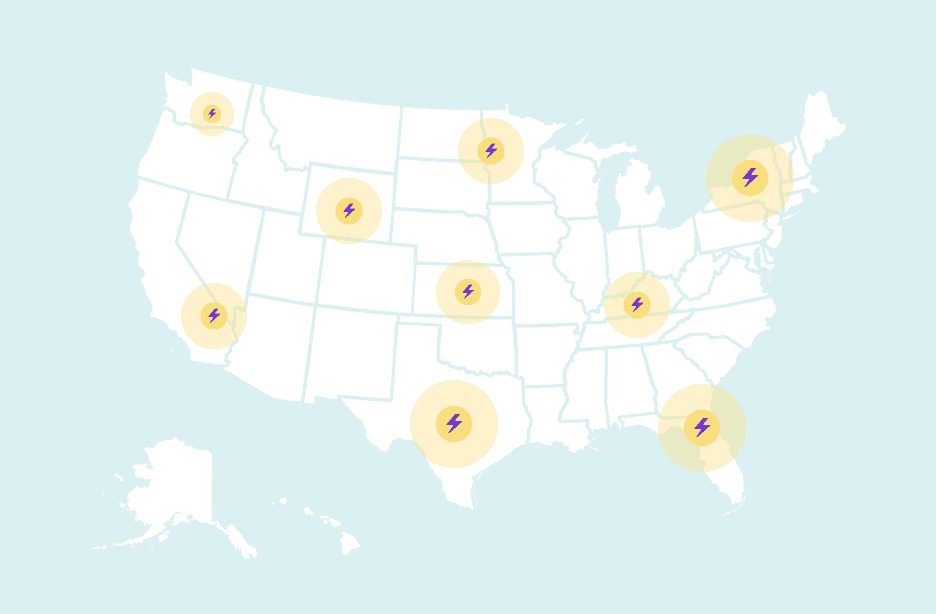CURRENT MEMBERS
200+
STATES
33+
Why join?
The local government leaders coalition gives you the charge you need to electrify your community. Electrification reduces emissions, improves health, and creates good-paying jobs that can’t be outsourced. From policy and tools to media coverage and opportunities to connect with leading government and business partners, our coalition helps you accelerate your goals and expand electric opportunity for your community.
What you get
Electrification resources for local leaders
Our one-stop toolkit has all the Rewiring America resources needed to support local leaders around the county. Learn about federal funding opportunities to spark electrification in your community, electrification education resources for your staff and constituents, case studies of innovative local electrification pilots and programs, and our local pace-of-progress tool to measure your community’s own electrification pace-of-progress.

Policy design + support
Our team offers support and actionable recommendations to simplify the local electrification journey and help you think through policy and programming.
Rewiring Communities
Selected communities that commit to electrification at scale will receive significant additional tailored policy, technical assistance, and financing support from Rewiring America and our partners to help you succeed.
Connection + amplification
We provide networking opportunities with local, state, and federal officials as well as business leaders from around the country. We will help you organize and execute educational events and provide thought leadership opportunities supported by our media team.
Mayor,
Menlo Park, California
As a local elected official working on climate action policy, it’s incredibly helpful to sit in a (Zoom) room with other leaders from across the country who are working on similar issues. Rewiring America, among all the other great work they’re doing, is playing an essential role in bringing local climate champions together to compare notes, share ideas, and learn from one another. They truly embody the spirit of ‘we're all in this together!’

Mayor,
Rutledge, Pennslyvania
As the mayor of a small borough in Pennsylvania, Rewiring America has been a strong partner for electrification as a means to attain climate stability, energy conservation, and cost savings. The Rewiring America staff have a prescient ability to distill complex technical topics, climate science, and policy into simple and actionable items. For example, one of my favorite tools is the IRA Calculator. Partnership with Rewiring America’s Local Leaders for Electrification can help communities more easily improve quality of life, mitigate climate change, and act on environmental justice.

Council Member - Ward 2,
City of Overland Park, Kansas
As a local elected official, I want to do all I can to help my community innovate, save money, and do our part to reduce pollution through electrification. Technology and policy changes are coming rapidly and I appreciate having Rewiring America dedicated to helping me keep up to effectively advocate for my corner of the world.

Mayor,
Burlington, Vermont
Burlington was recognized as the first city in the nation to source our electricity from 100 percent renewable generation in 2014. Building on that accomplishment, I've worked as mayor to advance our efforts in Burlington to meet one of the most ambitious local climate goals in the country — to become a Net Zero Energy city by 2020 across the electric, thermal, and ground transportation sectors. Through our own city fleet, Burlington is embracing electrification as a strategy that can help us decarbonize while supporting a strong local economy and better, healthier lives for our residents. Communities can and must lead on climate, and I'm proud to be a Mayor for Electrification with Rewiring America leading the charge.

Alderman,
Chicago, Illinois
Whether it’s more frequent and severe flooding, growing lakefront erosion, a diminishing tree canopy, or rising energy costs, climate change is wreaking havoc across Chicago — and it’s not letting up. I’m grateful for the opportunity to work alongside Rewiring America and other climate leaders to help Chicago do its part in tackling the climate crisis head on by expanding EV charging infrastructure, decarbonizing new and existing buildings, and increasing our reliance on renewable energy.

What you’ll do
Join the coalition
Empower your constituents by sharing Rewiring America electrification tools and materials and/or
Take our electrification pledge

Engage
Participate in Rewiring America events and virtual sessions, and access coalition resources.
Collaborate with and learn from fellow members.
Receive policy support and technical assistance.
Take action
Pass policies and incentives to help constituents electrify.
Leverage your leadership to educate others about electrification from individuals to federal policymakers.
Rewire your community
Access our resources to create a plan to electrify your community.
Commit to electrification at scale by joining Rewiring Communities.
Interested in the coalition but want to learn more?
Complete this form to talk with our team.
Still have questions?
How can I join the coalition?
You can join the coalition by doing one or both of the following:
Empower your constituents by sharing Rewiring America electrification tools and materials and letting us know you’ve done so!
Take our electrification pledge by submitting this form.
What is the pledge?
The pledge is a commitment to electrify. This means different things for different communities, depending on where you are at in your electrification journey. This coalition and Rewiring America’s resources aim to support and guide you along a path to electrification. The pledge states: As Mayor / Municipal Leader, I pledge to electrify my city / county. I will:
Build support for policies to help our homeowners and renters at every income-level and businesses of all sizes electrify their homes and buildings and charge their EVs
Work to replace fossil-fueled machines in municipal-owned buildings and fleets with clean electric appliances and vehicles
Reach out to businesses and support the creation of good quality jobs, equitably transitioning from fossil fuels through electrification
Use my voice in Washington, my state, around our community, and with the news media to support and educate others about electrification as the means to realize a fossil fuel-free future
Is Rewiring America a nonpartisan organization?
Yes. We are a nonpartisan 501c3 nonprofit organization that does not endorse candidates or participate in electoral activities.
Will we share your contact information?
No, Rewiring America will not share or sell contact information. If both parties agree, we may share contacts within the coalition to help facilitate connections and partnership opportunities.





































